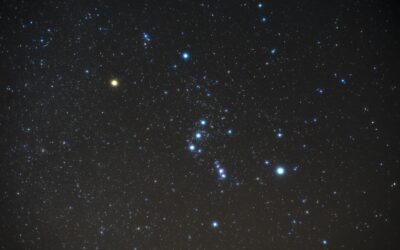Fact of the Matter: The What and the Where
Holly Enzmann
Recently, V.P. Michelle Snyder and I finished our first major sort of printed material in the Archive and found some pretty amazing research done by Dr. Enzmann. My primary focus is currently on the Astronomy and Planetology packets so I can uncover whatever I’m able to on Bob’s infamous and unconcluded Order Theory.
I am not exaggerating when I say we found galactic timelines that span back to “c.15,000,000,000 BC” (I assume BC?). In one intricate packet of papers, Bob explains that since the formation of the Milky Way, three or four generations of stars have formed. He states that the Sun orbits the Milky Way barycenter once every approximately 250 million years; the measurement of one Solar Galactic Year. The Sun also bobs up and down in the galactic disk as it orbits, and one cycle of this bobbing is a galactic month; it moves 1) down to the disc, 2) down from the disk, 3) up to the disk, and 4) up from the disc. These are the four weeks in the Solar Galactic Month. Since the conception of our Sun within a Giant Molecular Cloud, as of today, it would be about 20 galactic years old. As I sift through his work I wonder how long the average lifetime of a star is and how long a generation of stars would last.
We have many of Bob’s written processes for sequencing cosmological eras back to unbelievably early dates in these stacks, all of which are chronologically ordered and named (obviously, this is Bob we’re talking about). For example, I have a document here where he’s written dates from the Precambrian Era of c. 590,000,000 – c. 570,000,000, all the way up to the Kennewick Man Era in 7200 BC, with all eras named and explained.
He writes that c. 4,500,0000,000 was the end of the Hadean Era and the start of the Early Precambrian Era, when our atmospheric layers began to encircle our forming planet. He then includes the early stages and processes of our Sun and the Earth’s development. I type it as I see it:
- 4,800,000,000 – Sun’s Early Red Giant Stage
- Earth’s 1st atmosphere is lost
- Planetology largely concerns -1st, 0th, +1st, +2nd, +3rd and +4th Orders
- Earth’s mantle and core Iron-Nickel Drip-heating
- 4,700,000,000 – Impact forms moon
- Mars-size planet hitting earth rips off lithosphere & asthenosphere to form pre-lunar Earth-ring
- Earth’s 2nd atmosphere
- [blank] – Heavy Bombardment
- Earth: Rift-Line Oases and Lakes
- 4,550,000,000 – Late Intermittent Heavy Bombardment
- Major LUNAR MARIE
- [blank] – Light Bombardment begins
- End of light bombardment -c. [blank]
Honestly, I’m starting to relate to the cliché humble scholar who finds a buried, ancient library of knowledge and decides to just die there.
Bob includes these extensive timelines at the beginning of many of his papers. Since the 1940’s he knew that studying the formation of the Earth and our Sun was a surefire way to begin studying the formation of the Milky Way, and therefore other galaxies, and of course, then our universe’s processes. He spent nearly a century writing and researching fields like R.A.D.A.R. (Radio Detection and Ranging) and Geomorphology, all eventually tying into cosmology and historical astronomy. He seems to need to start at the beginning, the VERY beginning (like, of all time if possible), every time he begins a new document. He was diligent about keeping things in order. Orders, timelines, sequence of events. Categorize, reference, and grow. This was his approach to research and writing, and being a space mission planning extraordinaire, his favorite study subject was Earth.
“The scientific study of the origin and evolution of topographic and bathymetric features created by physical, chemical or biological processes operating at or near the Earth’s surface” is Wikipedia’s current definition of Geomorphology. Classical Geomorphology was strictly based off topographic observations and stuck to simply describing those features and relationships, although observation techniques have greatly expanded since its conception in the 19th century. Bob was featured in the Encyclopedia of Geomorphology in 1968 where he expanded on classic Geomorphology with Order Theory – an apparently rare appearance of Order Theory in the entire internet universe.
There are countless publications and textbooks on the geomorphic processes of weathering, mass wasting, erosion, and deposition. You can easily find out the composition and layers of the Earth’s core and when these processes initiated. Comparative Planetary Evolution is a study of the emergence of planets and their evolving planetary systems by comparing them to Earth’s formation and development. There is a world’s worth of information on Geomorphology, but I have found little online regarding the order of which these processes take place. M.J. Selby wrote a book called Earth’s Changing Surface: An Introduction to Geomorphology in 1985. Chapter 1: Basic Concepts for Geomorphology includes a small section called “Timescales: dating methods”, which I have yet to explore. I’m certain the order of earth’s formation processes is a great area of study. Still, nothing I have found references the Order Theory Bob refers to in the Encyclopedia and is constantly referring to in his work.
If you search for “Order Theory” on Google, many of your first findings will be related to the branch of mathematics dedicated to analyzing binary relation. Add the word “Planetology” to your search and you find definitions of Theoretical Planetology. Add “Geology” and you find articles and pages about Uniformitarianism, a doctrine that states Earth’s past geological processes act in the same way with the same intensity in the past as they do now, and is therefore very predictable. Close to order, but no cigar. Not even the tobacco, really.
If you google “Morphology”, you will likely see it first defined as the study of the formation of words in linguistics; but then also the study of form and structure of living organisms including plants and animals in biology, then finally, after digging deeper, defined as “the study of form and structure”. So, the morphology of any object can be studied, organized, and listed in chronological order.
Basically, I’m getting nowhere with finding published references to his Order Theory. I assumed that since the Encyclopedia uses Order Theory to expand on classical Geomorphology that it must already be published in full somewhere. This is glaringly not the case, so I decided to hit the Encyclopedia article again.
I start at the beginning. He begins by stating that since classic Geomorphology is based on and limited to Earth’s surface, he expanded it to include descriptions of objects geometrically, instead of just their upper surfaces. He emphasizes that classical orders should not be, and are not, just descriptions, but their sizing process is determined by the sum of all imposed external, internal, and stored energies, and are broken down into fragments described by quantum mechanics:
“Ultimately, all material structures, and hierarchies of material structures, are dominated by configuration of nuclear fragments, determined by various fields, as functions of time. These ultimate structures are described by quantum mechanics. Twelve orders have been designated as boundary conditions on hierarchies of organized matter in various states. Middle orders contain the most information.”
Each order is a representation of “boundary conditions”. Easy enough. I think these orders are also chronological from what I remember of my lessons, so as time passes and the Orders proceed from 1-12 (or 15…or 24, depending on the day or his mood), the mass of the described object gets smaller. He only writes here how the information available is plentiful in the middle orders, as opposed to the lower or higher orders having little attainable or available information (i.e. there is more information in a weathered boulder [5th Order] than there is in a pure element [10th Order] or a bodies prolateness or oblateness [1st Order]). But, if you think of it that way, it just means that 1st order hasn’t accumulated enough history (time) to be as complex as a weathered boulder… I continue to guess. So far, I’ve only found one other explanation touching on this phenomenon in an Archive document we randomly found called “Principals of Morphological Orders”:
“All entities within the universe can be classified into morphological orders. These orders are based on size. Coincidentally the organization of matter into entities in orders based on size is often, in addition, a classification based on forces acting to form, metamorphose and disperse the entities. The steps in the order classification are often also steps in sequences through which matter evolves through classes of entities.”
I think I’m on the right track. “…determined by various fields, as functions of time…” It rings in my mind. How many depictions of Chronos are we talking about here?
He continues to say that his expansion calls to first designate the type of body (Earth is a Terrestrial-type planet), second, designate its geosphere (Lithosphere for Earth), and finally, determine its prolateness or oblateness. Once these categories are established you can apply the 12 Orders, Bob’s version starting at Zero instead of 1.
After this, there are pages of different tables showing earth’s geospheric subdivisions sorted into Order layers. Nothing more on the association between time and the size of each Order’s mass. I looked at the clock and it was 12:30 a.m., so I decided to end the night with a cliffhanger.
I woke up the next morning, freshly curious. Back up to the archive room and back to the tables.
Sure enough, after a bit of rest, I discovered the remaining few paragraphs of the article that slipped my notice. My hand flies to my forehand as I immediately read:
“Ideally the twelve ORDERS represent sequences of material structures organized in lines of descent as matter and energy move from sources to sinks. Ultimately all objects of all orders must fall into either simple or complex lines of descent.”
So! From source to sink! From Gabble to Zatch! That makes sense. Right?
“The temporal duration of objects within orders as compared with the time rates at which unmanned or manned perform observations determines modes of description.”
…almost. Temporal duration? What is that? I’m sure you know, dear reader. Alas, I am yet a humble scientific journalist, for some inexplicable reason.
I Google: “Temporal duration of an object in space”.
It gives me: “What is Spatial Temporal?” and “Spacetime – Wikipedia”. I’ll go with….What is Spatial Temporal?
“Spatiotemporal Definition” tells me that Spatiotemporal, or spatial temporal, relates to space and time. Spatial refers to space, and temporal refers to time.
Thank you OmniSci.com, you’ve been… very helpful.
Let’s looks up the definition of Temporal. Merriam-Webster states: “1a) of or relating to time as opposed to eternity. 1b) of or relating to earthly life. 2) of or relating to tense or a distinction of time. 2a) of or relating to time as distinguished from space. 2b) of or relating to the sequence of time or to a particular time. I think we want a mix of 1a), 2a), and 2b).
So, simply enough, the temporal duration of objects within orders would be the …physical passing of time? I suppose, of all objects. So, the time rate of an unmanned or manned observation vs. the temporal duration of the object determines the mode of describing the order (i.e. synoptic graphs vs. mapping). We’ll just leave it at that.
He continues to say that all of those objects really represent relatively stable time-domain configurations in source-sink cascades. He claims there are indications that objects belong to one or another line of descent such as a vortex or wave, but can also be dominated by energies acting on lower-order continuums. The concept of the line of descent as energy moves from source to sink can be beautifully explained by a featured verse written by someone named “Rayleigh” (although when I look this up, I find it to be written by Lewis Fry Richardson):
“Big Swirls have lesser Whirls that feed on their velocity, and these Whirls have smaller Swirls and so down to viscosity.”
Turtles all the way down, eh Bob? I recall him saying something similar: “Big Fleas have smaller fleas upon their backs to bite ‘em, Small fleas have smaller fleas and so ad infinitum.”
Dr. Enzmann was obviously not satisfied with how the geomorphic process was classically described as it was limited to Earth, so he expanded it to allow room for this study to apply to other planets. With this expansion he ordered the formation of planets within our solar system, the formation of the solar systems themselves, then onto the formation of stellar groups, galaxies, and beyond.
Through many other means of online research, I find very little evidence of Order Theory being published elsewhere. My conclusion is that aside from the age of the material keeping it from being available on the internet, Order Theory may only be available in this Archive and in the Planetology and Space Mission Planning conference books Bob acted as Consulting Editor for in the ’60s. I can’t admit to immersive tangible research; I’ve barely utilized Bob’s extensive research library downstairs. For instance, I have a book here from 1997 called Quantum Origins of Cosmic Structure, by Rotterdam, Netherlands, and Brookfield – maybe I should give that a quick skim before I go making assumptions.
There are five references to these books in the Encyclopedia article. I will need to read and understand them the best I can as we explore the positive Orders together in this column. As you can imagine they are not light reading, so I have my homework ahead of me. Regardless, why spend time asking for answers when you haven’t explored for them down every path readily available to you first? So, on the Archive I rely, and from the Archive I relay!





